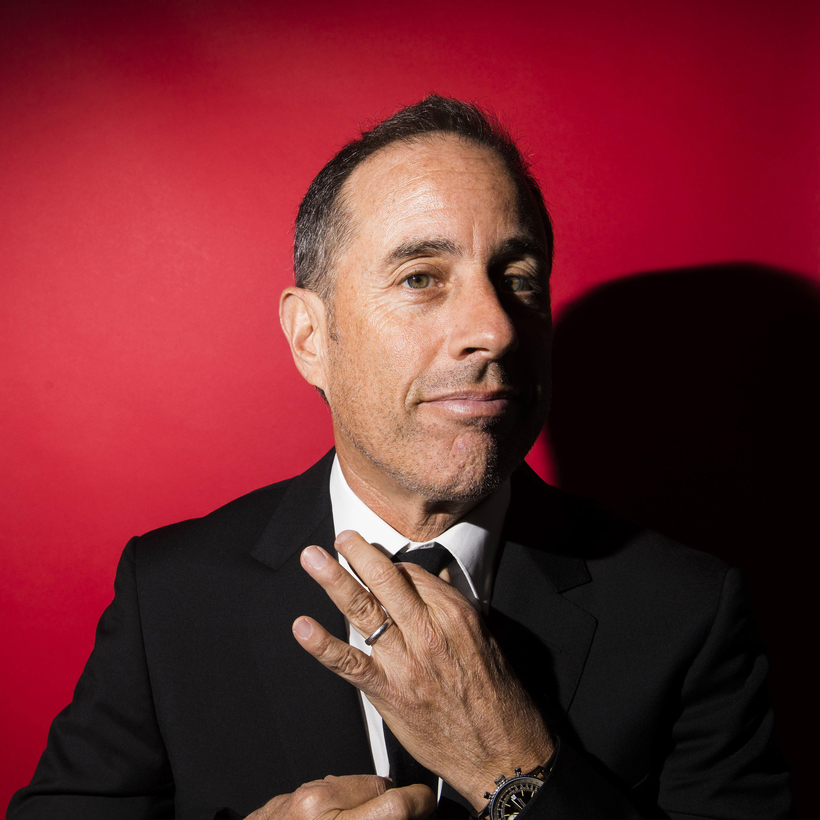Bob Hope, who died in 2003 at the age of 100, had many jokes written for him across his nearly eight decades in show business. Most of them he kept locked away in a fireproof, theft-proof vault in his Toluca Lake home—528,000 yuks in total, give or take a U.S.O. tour, filed alphabetically by subject. I’m lucky enough to own a handful of the actual articles, typed on index cards with subject headings, drawn from the collection of one of Hope’s longtime writers, a gift from a friend who bought the collection at auction last year.
One example:
FOOTBALL
Can you picture a football team made up of just mothers-in-law? Boy what interference.
If you are a fan of Jerry Seinfeld’s and you want to own a bunch of his jokes, you don’t need a generous friend with a hobby of bidding at celebrity auctions, because Seinfeld has just published a compendium of bits from his stand-up act—four-and-a-half decades’ worth. A joke vault in portable form! The book is titled Is This Anything? That question, the author explains, “is what every comedian says to every other comedian about any new bit.” In other words: Is this funny? In Seinfeld’s case, the response, far more often than not, has been “Yes! And not just anything but something.”
Once a Comedian …
It is a rare feat to be hugely successful, fabulously wealthy, and still widely respected by one’s peers, but as Judd Apatow wrote of Seinfeld in his 2015 book, Sick in the Head: Conversations About Life and Comedy, “No one else has his work ethic or his clarity of vision, his passion for the craft.” You get a sense of that drive, or compulsion, in Seinfeld’s intro to Is This Anything? (written using the same cadence-mimicking line breaks with which he presents his stand-up material):
The biggest comedians you can name still go onstage with a little worry in the back of their head, that whatever they have might not be good enough tonight.
We always want more.
I deeply love the endless, somewhat torturous struggle of never quite feeling that you’ve got your act where you want it.
Because I don’t want it to ever end.
And when a new bit breaks through and gets a real laugh,
that’s when you feel like you’re at the beginning of the journey all over again.
You feel like you’re just starting out.
And maybe you do have what it takes.
Like most comedians since Hope’s day, Seinfeld writes his own material—in longhand, on yellow legal pads—but he doesn’t open a vein onstage, doesn’t reveal much beyond his gift for poking at the mundane fabric of modern life and finding funny strings to pull. There’s a purity to Seinfeld’s routines, to the rigor of his comedic logic, which almost defies revelation. I mean, “I have always wondered, where are bugs going?” is not a Richard Pryor opening.
Seinfeld will joke about dating and relationships and marriage, but more from an anthropologist’s point of view than that of a battered, scarred participant. A long 23 years ago, I interviewed him for a Time magazine cover story on his decision to pull the plug on Seinfeld, the sitcom. He not only declined to discuss his personal life in even the vaguest, most genteel terms, he teased me for trying to get even that much out of him. And yet his autobiographical intro to Is This Anything? is so perceptive and engaging, as are subsequent interstitial glimpses of his offstage life, that I found myself wishing he’d written an honest-to-God memoir; he’s an observational comic, after all, and he’s surely seen some stuff.

Here, for example, is his piquant, if too brief, account of how his sitcom came to be:
I remember so well sitting there with Larry David at our pitch meeting for Seinfeld at NBC.
And I remember saying,
“We want the show to be about how a comedian gets his material.”
In my head I’m thinking,
“What a load of nonsense this is.
Is anyone dumb enough to believe what I’m saying?
But it does sound good.
I think that’s what this meeting is about …
Just say stuff that sounds good … ”
Then I threw in some bit I had about waitresses in coffee shops walking around
with a pot of coffee in each hand looking for people that had coffee, trying to give them more coffee.
That got a laugh.
And the next thing I knew I had a TV series.
Anti-Aging
The stand-up material is presented chronologically, by decade. Most of it reads funny on the page, especially if read with Seinfeld’s Long Island bray in your head. It helps, too, that his humor is rarely topical, so most jokes don’t date, though I did appreciate the time-capsule quality of this mid-1970s riff:
I see they just finished the Roosevelt Island Tramway.
That’s nice …
The city’s going bankrupt,
they’re putting up rides for us.
Next thing you know, there’ll be a roller coaster through the South Bronx.
That would be the first roller coaster where the people scream on the flat part of the ride.
I mean, “I have always wondered, where are bugs going?” is not a Richard Pryor opening.
If you have never seen or listened to Seinfeld’s stand-up, this—the page—is not the place to start. Check out one of his streaming specials or see if you can catch him trying out new bits at the Comedy Cellar, when we get to have nightclubs again. If you have seen Seinfeld’s stand-up, you know a lot of these bits already. Do you want them between covers? You may! Myself, I’m not sure I need to savor his work quite this way, though it’s interesting to chart the changes in Seinfeld’s life through his comic preoccupations.
He begins with riffs on suburban foibles and middle-class childhoods (“Where in the world do you get your balls to call a breakfast cereal LIFE?”). As he finds success in his peripatetic field, his gaze turns to the absurdities of air travel and hotels (“I think I’ve heard just about all the friendly little pilot chit chat I need to hear for the rest of my life”). By the end of the book, he’s complaining about meetings with lawyers, fancy restaurants where the meals take two and a half hours, and lavish children’s birthday parties with clowns and bouncy houses (“Basically, it’s a small portable insane asylum for children”). Seinfeld does seem to have soured a bit with age, growing more irritated than amused when it comes to humankind’s quirks, but even when he was young you could sometimes detect a fastidious lip curl behind a lot of his material. Otherwise, his psyche remains impenetrable. The last and presumably most recent bit here is not a wry reflection on success or comedy or aging or family but an extended riff on Flex Seal infomercials. That one likely won’t endure. But here’s a bit that Juvenal or Martial would have found funny back in ancient Rome and that I bet people might still laugh at in another two thousand years:
I saw a study that said,
The number one fear of the average person is public speaking.
Number two is death.
Death is number two!
How in the world is that?
That means to most people,
if you have to go to a funeral,
you would rather be in the casket than doing the eulogy.
Bruce Handy is a journalist and the author of Wild Things: The Joy of Reading Children’s Literature as an Adult


